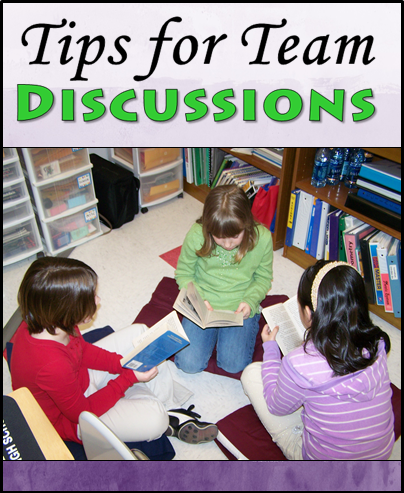http://corkboardconnections.blogspot.tw/2013/01/cooperative-learning-more-than-group.html
這篇文章教導幾個合作學習分組討論的技巧.
一組中總有dominate 很有自己意見也會分享自己想法的學生, 也有很shy 的學生.
文章中提及的做法則可以讓小組內每個學生有equal participation, 都有機會發表自己的意見.
也建議老師使用Question cards 讓小組討論的內容更聚焦!
很實用的文章 :) ! smile 表情符號 !
Cooperative Learning - More Than Group Work
Did you know that there's a difference between cooperative learning and group work? I'll bet you thought those two terms were synonymous, but they're not. Let me show you how they are worlds apart.
Does this scenario sound familiar? The teacher assigns a group project, outlines the task, and gives a deadline for completion. Students are expected to work together and participate equally, but we all know what happens. The self-appointed leader takes over, makes all the decisions, and does most of the work. Other team members may contribute, but some do nothing or even become a distraction to the real work. When the final project is turned in, everyone gets the same grade no matter what they contributed to the project.
But what I just described is NOT cooperative learning. The scenario I described above is nothing more than unstructured group work, and there’s nothing research-based about it. No wonder it still gets a bad rap in some educational circles!
But if that's not cooperative learning, what does cooperative learning look like? I discovered the answer to this almost 20 years ago when I was first trained in the "structural" approach to cooperative learning developed by Dr. Spencer Kagan. In this model, academic tasks are structured or divided so that everyone participates equally and all students are held accountable. Dr. Kagan developed a wide variety of structures that have since been adopted by teachers all over the world, strategies that take the "group work" out of cooperative learning. I began implementing these strategies in my own classroom and found them to be extremely effective.
Easy Team Discussion Strategies

Introducing accountability and rules of equal participation can be as easy as changing to a new team discussion format. Remember the scenario I mentioned above in which one person on the team does all the work? The same thing often happens in a team discussion when a teacher asks students to “talk it over with your team.” The assertive students dominate the discussion and the shy ones never have an opportunity to talk.
To equalize participation in team discussions, try one of these strategies:
- Around the Team - Place students in teams of 4 or 5 and have them number off in order around the team. After you pose a question, students take turns responding in numerical order. To provide even more structure, give each team member a certain amount of time to respond such as 30 seconds or a minute.
- Pairs Discuss & Teams Share - Pair students with one discussion partner and have them first discuss a topic together, and then share their ideas with the whole team. When two students talk to each other, it's more likely that they will both have a chance to express their ideas. Then when they talk with the team, all four ideas can be presented.
- Talking Sticks - Use objects such as plastic chips or craft sticks to equalize participation. Dr. Kagan suggests chips, but I use craft sticks because those chips roll everywhere! I assign a discussion leader, and that role changes for each new discussion question. The leader gives each student 3 sticks to hold during the discussion. When a question is presented, students who want to respond place a craft stick into a plastic cup. When students run out of sticks, they have to be quiet and listen to the rest of their teammates until all sticks are in the cup. When all of the sticks have been used, the leader passes them out again and the discussion continues where it left off.

The structural approach to cooperative learning encourages a high level of structure at first, with a gradual transition to less structure as students learn to work effectively in teams. As a case in point, the three methods described above are great ways to begin teaching your kids how to participate in a team discussion. However, because they are so structured, they are really just the first steps. The Common Core Speaking and Listening Standards require students to connect their ideas to others and to build upon other's ideas in a discussion, which is a skill that must be taught explicitly. To read strategies that address more advanced discussion skills, read my post Teaching Kids How to Have REAL Discussions.
Keep Discussions Focused with Question Cards
You can use question cards in almost any subject area. to see examples of the types of questions that work well, take a look at my Talking Sticks Discussion cards shown here.
I have also created sets of Talking Sticks question cards based on Common Core Informational Text and Literature Standards for each grade level, Kindergarten through 5th grade. You can find all of my Common Core Talking Stickspacks in my TpT store.


沒有留言:
張貼留言